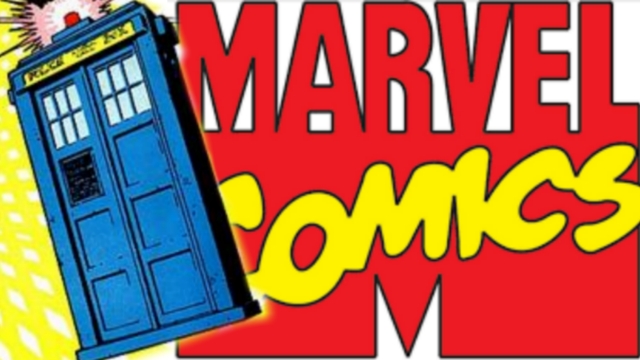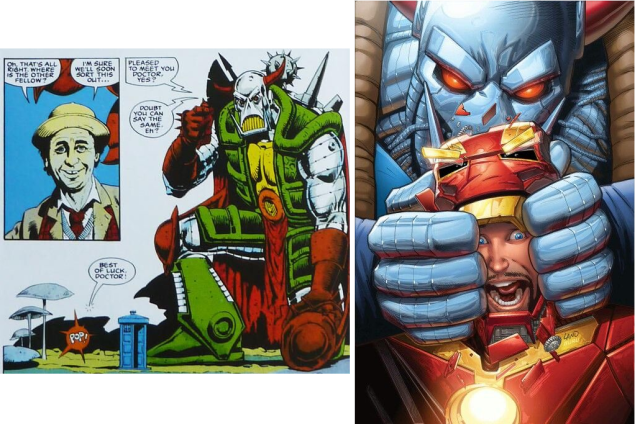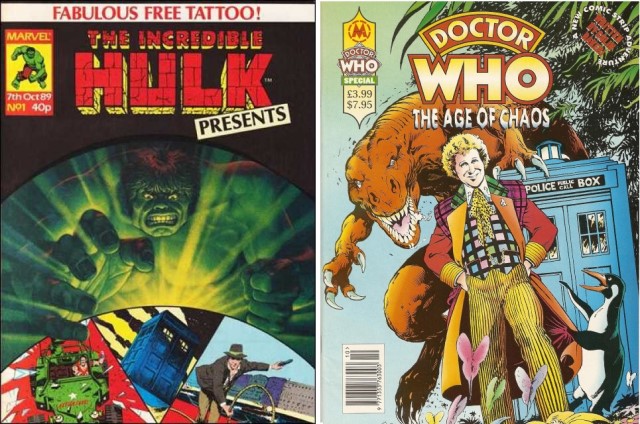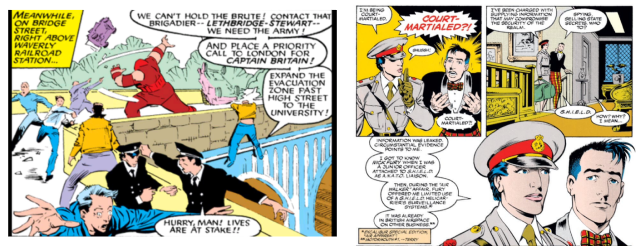Doctor Who has long been billed as the show than can go anywhere, do anything, and be anything. But thanks to a combination of a quirk of licencing, and some huge Who fans writing the adventures of the Earth’s mightiest heroes, once or twice it’s gone somewhere very unexpected – the Marvel Comics universe.

When Doctor Who Magazine, originally titled Doctor Who Weekly, arrived in British newsagents in 1979 it came courtesy of Marvel UK. American comic book publishing giant Marvel Comics had set up its British arm in 1972 with the aim of reprinting adventures by the likes of Spider-Man and the Hulk for the lucrative British comic market. But by the late 1970s, Marvel UK was also creating new stories of its own, written and drawn by British creators and more responsive to the competition of rising stars like the UK’s homegrown 2000 AD.
One of the most popular of these Marvel UK titles was Transformers, based on the popular cartoon series and toys. In fact, so well received was Transformers that its lead writer Simon Furman began to write the American version of the comic as well. One of the many innovations Furman brought to Transformers was the character of Death’s Head – the grumpy, materialistic, strictly professional, robot ‘freelance peacekeeping agent’ (that is, bounty hunter) who had no interest in the Autobots’ and Decepticons’ notions of good and evil – only in who was paying his bills.

During the Marvel Comics years, the Doctor’s adventures included cameos from everyone from Dr. Strange to Namor, but Death’s Head remains the Whoniverse’s enduring Marvel legacy
When the decision was made to spin Death’s Head off into his own title, he needed to be literally brought down to size. His reduction from 30′ tall colossus to a more manageable 6’6″ came at the hand of the Seventh Doctor and one of the Master’s old Tissue Compression Eliminators. The two would later have a rematch when Doctor Who Magazine villain Dogbolter would employ Death’s Head to eliminate the Doctor, though he soon realised the frog-like billionaire intended to kill them both, breaking the contract.
Significantly their trip in the TARDIS leaves Death’s Head in the present day Marvel Universe atop the Fantastic Four’s Baxter Building headquarters. Over the next few years, Death’s Head would continue to have encounters with the likes of Iron Man and She-Hulk. He even spent a time as an agent of the Time Variance Authority, as seen in Disney+’s Loki.
The Doctor and Death’s Head would cross paths again in Doctor Who Magazine #173, this time on more friendly terms as the Doctor visits a bar populated by, among others, Death’s Head (who raises his drink to the Time Lord), and other Marvel characters like the Silver Surfer, Captain Britain, the Hulk and Dr Strange.
Ultimately, the Death’s Head story ‘The End… Yes?’ guest stars the Doctor as he untangles the timey wimey complications of a younger and an older version of Death’s Head trying to kill each other. And for good measure, he reveals his own part in the bounty hunter’s previously mysterious origins, being the one who had originally stolen Death’s Head’s inert body from his creators and making it a sentient, independent being.

As well as reprints of the DWM strip, Marvel Comics also produced original Doctor Who stories like ‘Age of Chaos’
Panini would take over the British licence for Doctor Who comics in 1995, while the American licence would pass through companies like IDW to current holder Titan Comics. But Death’s Head remains a recurring part of the Marvel universe; most recently, he once again had his own mini-series in which he teamed up with Kate Bishop (from Hawkeye) and Wiccan (one of the twins from WandaVision). As such, he remains Doctor Who’s most enduring mark on the Marvel Comics universe.
But even when not crossing over directly with Marvel characters, there was still a connection during the Marvel UK period. As well as reprinting selected DWM comics for the American market, Marvel created a Doctor Who backup strip in the newsstand anthology book The Incredible Hulk Presents. For ten issues, Marvel Comics provided new adventures for the Seventh Doctor, in addition to the regular Doctor Who Magazine.
Among its pages were stories like ‘Who’s That Girl!,’ introducing a woman claiming to be a future, female incarnation of the Doctor, and ‘Niveneh!,’ which foreshadowed ‘The Doctor’s Wife’ with its TARDIS graveyard and incorporeal adversary luring Time Lords to their deaths.
And in 1994, the Sixth Doctor himself, Colin Baker, teamed up with Marvel Comics to write Doctor Who: The Age of Chaos, an eight issue mini-series in which Baker’s Doctor and his companion, the shapeshifting penguin called Frobisher, decide to check in on the grandchildren of their old friend Peri.
The Doctor Who universe even continues to have its own number in the Marvel multiverse. While the main line of comics is set on Earth-616 and the Marvel Cinematic Universe is Earth-199999, the Marvel map of the multiverse place the events of Doctor Who on Earth-5556.

More unofficial Doctor Who influences on Marvel Comics have included Brigadier Stuart of WHO
There have been other links over the years. The Brigadier, Benton and UNIT memorably had cameos in an issue of X-Men, reduced to tidying up the mess left by the X-Men’s battle with the Juggernaut during a visit to the UK. But sometimes, especially since Marvel no longer had the licence, the references are unofficial and more subtle.
In Excalibur #6, legendary comic book writer and Doctor Who fan Chris Claremont introduced the WHO (Weird Happenings Organisation.) A paramilitary organisation formed to protect British shores from the uncanny and alien, WHO was even led by a Brigadier… Brigadier Alysande Stuart. Meanwhile, her twin brother Alistaire Stuart was WHO’s chief scientific advisor, and resident genius.
Even the movies have been influenced by Doctor Who, with X-Men: Days of Future Past partly influenced by a classic Jon Pertwee adventure
Doctor Who has even had an impact on the Marvel movies. Classic X-Men comic writer John Byrne acknowledged that his epic storyline, Days of Future Past, had been subconsciously influenced by the Doctor Who story ‘Day of the Daleks.’ In this classic adventure, the future is ruled over by Daleks, while rebels travelling back in time to assassinate a politician risk causing the very chain of events they’re trying to prevent.
Meanwhile, in ‘Days of Future Past,’ the relentless robot Sentinels have conquered America in the future, and the surviving X-Men try to use time travel to prevent the political assassination they believe triggered that chain of events. This comic story was later adapted into the movie X-Men: Days of Future Past, starring Hugh Jackman, Patrick Stewart and Ian McKellen. So, if you squint hard enough, you could almost consider it an unofficial third Daleks movie…
For the foreseeable future, any Doctor Who references in Marvel Comics will likely be subtle nods and homages. But which Marvel characters would you like see the Doctor encounter on the page or on screen? Perhaps the TARDIS should touch down in the TVA, or perhaps Death’s Head could come knocking at the Doctor’s door…

Doctor Who Seventh Doctor scarf – order now from the Lovarzi shop!








Leave a Reply